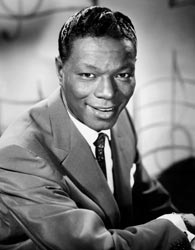Nat King Cole’s musical upbringing forged a career that would delve the nuances of the jazz trio and fashion a more subtle approach to singing. Although his life was curtailed, he managed to both treat and test his popular and critical audiences.
Nat King Cole’s Early Days
Nat King Cole was born Nathaniel Adams Coles on March 17, 1919 (some sources say 1917), in Montgomery, Alabama, to a Baptist pastor and his wife. In Cole’s early childhood, the family moved to Chicago. Cole’s mother, Perlina, worked as choir director at her husband’s church and fostered an interest in music in her children.
Cole began taking piano lessons as a teen and would also occasionally play the organ during church services. In high school, he fell in love with the swing of South Side jazz. Cole and his older brother Eddie spent much of their spare time club-hopping, taking in the talent and technique of performers such as pianist Earl Hines.
“It was his driving force that appealed to me,” he recalled to Down Beat in 1957. “I latched onto that new Hines style.”
Cole dropped out of school at age 15 to play piano in Eddie’s quintet, Solid Swingers. In 1936, the Swingers appeared on several records for Decca’s “Sepia Series,” which targeted black audiences. While these efforts did not garner much popularity, the thrill of hearing his songs on vinyl encouraged Cole to pursue a career in music.
Sources in this Story
- PBS: American Masters: Nat King Cole
- NPR Music: Nat King Cole: ‘The Pianist’
- Biography.com: Nat King Cole Biography
- NPR Music: Nat King Cole: ‘After Midnight,’ ‘Best of the Nat King Cole Trio’
Cole’s Notable Accomplishments
The two brothers received their first big break in 1937, when they were asked to tour with the revue Shuffle Along. Perhaps swept up by the romance of life on the road, Cole quickly courted and married dancer Nadine Robinson. When the revue was discontinued in Long Beach, California, Cole had his first taste of the financial tenuousness of the traveling performer and was forced to “play every beer joint from San Diego to Bakersfield” to make ends meet.
Cole finally found consistent work at Los Angeles’s Century Club and was spotted by Bob Lewis, who invited him to play at the Sewanee Inn. Unsatisfied with Cole’s lack of a stage name, he dubbed him “King Cole” and the nickname stuck. Cole formed the Nat King Cole Trio with bassist Wesley Prince and guitarist Oscar Moore and the three set out to tour the country.
Jazz critics tend to regard this period of Cole’s life fondly, as he began to explore and expand upon traditional jazz piano technique, often subverting normative musical structure for playful syncopation. Also striking about Cole’s trio—aside from the fact that trios were still rare in the 30s and 40s—was its lack of a drummer.
After signing with Capitol Records in 1943, the trio produced a string of hits: “Straighten Up and Fly Right” (named after one of Cole’s father’s sermons), “Route 66,” and “For Sentimental Reasons.” Although Cole was willing to provide vocals for some of the trio’s pieces, his voice was rarely the highlight. This changed with his performance of Mel Torme’s “The Christmas Song” in 1946. With flourishing string accompaniment, Cole’s velvety voice was center stage—a significant break from his previous work.
Some jazz purists were critical of this move toward the mainstream, but Cole heeded the advice of friend and fellow singer Maria Ellington. “Maria saw that he had a limited future as a jazz pianist,” Duke Niles, a friend of Cole, told biographer Leslie Gourse. When Cole’s friendship with Ellington escalated into romance, he obtained a divorce from Nadine Robinson and married Ellington in 1948. In the ensuing years, Cole continued to churn out popular numbers like “Mona Lisa,” “Unforgettable,” and “Too Young.”
The Man and His Work
- “After Midnight: The Complete Session”
- “Nat King Cole: The Christmas Song”
- “Nat King Cole: Love Songs”
- “The Unforgettable Nat King Cole”
The Rest of the Story
At the peak of his stardom in 1956, Cole was offered his own TV show on NBC. However, the difficulty of finding sponsors for a show with an African-American host prevented it from being picked up for more than a year.
This setback did not discourage Cole, though; his 1956 album “After Midnight” received critical acclaim and in the early 1960s, he produced the popular successes “Ramblin’ Rose” and “Those Lazy-Hazy-Crazy Days of Summer.”
A heavy smoker throughout his career, Cole suffered a sharp decline in health and was diagnosed with lung cancer in late 1964.
He died on February 15, 1965, in Santa Monica.
This article was originally written by Devin Felter; it was updated January 24, 2017.











